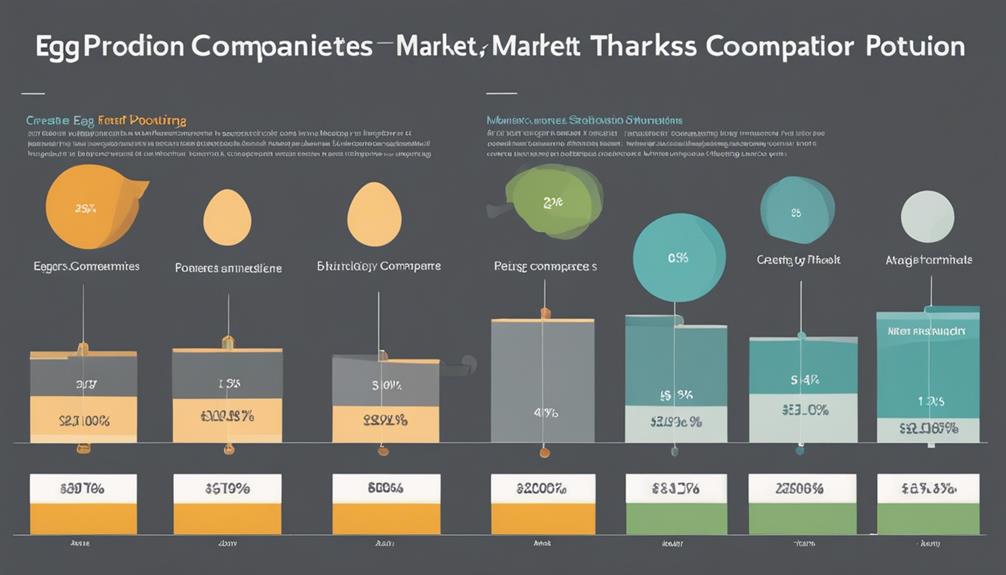Why Is a Business Plan Crucial for Egg Production?"
A well-crafted business plan is essential for egg production because it provides a structured framework that drives decision-making, financial management, and operational efficiency. By meticulously outlining your goals, analyzing market trends, and developing operational guidelines, you set your business up for success. But there's one crucial aspect that often gets overlooked—risk management. In a volatile industry like egg production, understanding potential risks and having strategies to mitigate them can mean the difference between failure and sustainable growth. Let's explore why risk management in your business plan is the key to securing your profitability and longevity in the egg production market.
Importance of Strategic Planning
Strategic planning is essential for ensuring the long-term success and sustainability of an egg production business. By carefully mapping out your goals, resources, and tactics, you set the foundation for achieving long term sustainability. Planning allows you to anticipate challenges, identify opportunities, and adapt to changes in the market, thereby increasing your business's growth potential.
One key aspect of strategic planning is setting clear objectives that align with your long-term vision for the business. These objectives should be specific, measurable, achievable, relevant, and time-bound (SMART), guiding your actions towards sustainable growth. By defining these objectives, you provide your team with a roadmap to success, fostering a shared sense of purpose and direction.
Moreover, strategic planning involves analyzing your strengths, weaknesses, opportunities, and threats (SWOT) to make informed decisions. Understanding these internal and external factors helps you capitalize on your strengths, address your weaknesses, seize opportunities, and mitigate risks. This analysis is crucial for developing strategies that leverage your competitive advantages and position your egg production business for long-term success.
Market Analysis and Trends
To position your egg production business for long-term success, understanding market analysis and trends is imperative. Consumer preferences and demand play a crucial role in shaping the direction of the egg industry. By staying informed about what consumers are looking for, such as organic, free-range, or specialty eggs, you can tailor your production to meet these preferences and stay ahead of the competition.
Additionally, monitoring consumer demand allows you to adjust your production levels accordingly, preventing wastage and optimizing profitability.
Technological advancements and automation are also key factors impacting the egg production market. Implementing innovative technologies can streamline processes, improve efficiency, and reduce costs in the long run. Automation, such as robotic egg collectors or smart monitoring systems, can enhance productivity and ensure consistent quality control.
Keeping abreast of these advancements and being willing to invest in them can give your business a competitive edge and help you meet the evolving needs of the market.
Financial Forecasting and Budgeting
Understanding your financial forecasts and creating a comprehensive budget are essential components of efficiently managing your egg production business. Profit projection is a key aspect of financial forecasting. By analyzing market trends and setting realistic revenue goals, you can estimate your potential earnings accurately. This allows you to make informed decisions about resource allocation and expansion strategies.
Expense tracking is equally crucial. By monitoring your costs diligently, you can identify areas where expenses can be reduced, thus improving your profit margins. Implementing cost management strategies such as negotiating better deals with suppliers or optimizing operational processes can lead to significant savings over time.
Creating a detailed budget helps you allocate resources effectively. It enables you to plan for recurring expenses like feed, utilities, and labor, ensuring that you have sufficient funds to cover these costs without impacting your operations. Additionally, a budget provides a financial roadmap, guiding your business towards its goals and highlighting any deviations that need to be addressed promptly.
Operational Guidelines and Procedures
Efficient operational guidelines and procedures are vital for the smooth functioning of your egg production business. To ensure production efficiency and maintain quality control, it's imperative to establish clear protocols and workflows. Implementing standardized operating procedures for tasks such as egg collection, sorting, and packaging can streamline operations and minimize errors. Regular quality checks should be conducted to uphold high standards and meet customer expectations.
Staff training plays a crucial role in enhancing operational effectiveness. Providing comprehensive training programs for employees on handling poultry, identifying potential issues, and following safety protocols can significantly improve overall productivity. Continuous education and skill development empower your workforce to perform at their best, contributing to the success of your egg production venture.
Moreover, regular equipment maintenance is essential to prevent costly breakdowns and downtime. Establishing routine maintenance schedules for machinery such as egg graders, incubators, and feeders can prolong their lifespan and ensure optimal performance. Conducting periodic inspections and addressing any issues promptly will help avoid disruptions in the production process.
Risk Management Strategies
Implementing robust risk management strategies is crucial for safeguarding your egg production business against potential threats and uncertainties. To begin, conducting a comprehensive risk assessment is essential. Identify all possible risks that could impact your business, such as disease outbreaks among your flock, supply chain disruptions, or adverse weather conditions affecting production. By understanding these risks, you can develop contingency planning to minimize their potential impact.
Mitigation strategies play a key role in risk management. Once risks are identified, prioritize them based on their likelihood and potential severity. Implement measures to reduce the probability of these risks occurring, such as biosecurity protocols to prevent disease spread or diversifying suppliers to mitigate supply chain disruptions. Additionally, having a crisis response plan in place is critical. Outline clear steps to follow in case of emergencies, such as a sudden decrease in egg demand or a food safety issue.
Marketing and Sales Strategies
To effectively drive growth and profitability in your egg production business, crafting a well-defined marketing and sales strategy is paramount. Brand positioning is a key aspect of your strategy. It involves establishing a distinct and desirable image for your egg products in the minds of consumers. Highlighting what sets your eggs apart, whether it's organic, free-range, or locally sourced, can help create a strong brand identity that resonates with your target market.
Customer segmentation is another critical component of your marketing and sales strategy. By dividing your market into different segments based on factors such as demographics, behavior, or preferences, you can tailor your marketing efforts to specific customer groups. For example, you may choose to target health-conscious consumers with high-quality, nutritious eggs or convenience-seeking customers with pre-packaged egg products.
Understanding your target customers' needs and preferences is essential for developing effective marketing campaigns and sales tactics. By identifying the unique value proposition of your eggs and communicating it clearly to the right customer segments, you can attract and retain loyal customers. Additionally, analyzing market trends and staying informed about consumer preferences can help you adapt your marketing and sales strategies to remain competitive in the egg production industry.
Competitor Analysis and Positioning

Conducting a thorough analysis of your competitors and strategically positioning your egg production business in the market are essential steps for achieving sustainable growth and a competitive edge. Understanding your competitors' strengths, weaknesses, products, and pricing strategies is crucial in developing your own unique selling proposition.
To begin, focus on product differentiation. Analyze what sets your eggs apart from those of your competitors. This could be the quality of your eggs, the farming practices you employ, or any unique selling points that could appeal to consumers. By highlighting these differences, you can carve out a distinct position in the market and attract customers who value these specific characteristics.
Moreover, consider your pricing strategy concerning your competitors. Are you aiming to be a premium provider with higher prices but superior quality, or do you want to target budget-conscious consumers with more affordable options? Understanding how your competitors price their products can help you make informed decisions about where you fit in the market and how you can leverage your pricing to attract customers.
Monitoring and Evaluation Processes
Effective monitoring and evaluation processes are vital components for assessing the performance and progress of your egg production business. Performance tracking allows you to measure your business's success in meeting set goals and objectives. By consistently monitoring key performance indicators such as egg production rates, feed conversion ratios, and mortality rates, you can identify areas that require improvement and make informed decisions to enhance overall efficiency.
Feedback plays a crucial role in the monitoring and evaluation processes of your egg production business. Regularly seeking feedback from employees, customers, and suppliers can provide valuable insights into areas needing attention. For instance, customer feedback on egg quality can help you implement quality control measures to ensure consistent product satisfaction. Similarly, feedback from employees on production processes can lead to operational improvements and increased productivity.
Quality control is another essential aspect that falls under the monitoring and evaluation processes. Implementing quality control measures at every stage of the production process, from sourcing feed to packaging eggs, ensures that your products meet the highest standards. Continuous evaluation of these processes allows for ongoing improvement, leading to higher-quality products and increased customer satisfaction.
Frequently Asked Questions
What Are the Best Practices for Egg Production Facility Design?
When setting up an egg production facility, consider these key factors:
- Lighting efficiency for optimal egg laying conditions
- Ventilation control to maintain air quality
- Strategic equipment layout for efficient workflow
- Effective waste management systems
These practices are crucial for maximizing production output and ensuring the well-being of your flock.
How Can Technology Improve Efficiency in Egg Production?
To enhance efficiency in egg production, consider integrating technology like automated monitoring systems and data analytics. These tools can provide real-time insights into production processes, allowing for quick adjustments and optimizations.
Additionally, robotics can streamline repetitive tasks, while leveraging technology in the supply chain can improve inventory management and distribution. By embracing these technological advancements, you can boost productivity and profitability in your egg production operations.
What Are the Regulatory Requirements for Egg Labeling?
When it comes to egg safety, understanding labeling guidelines is crucial. Compliance with regulatory requirements ensures that consumers receive accurate information about the eggs they purchase. Proper labeling can include important details such as expiration dates, handling instructions, and nutritional information.
How Can Egg Producers Ensure Animal Welfare Standards?
To ensure animal welfare standards, egg producers must conduct regular welfare audits to assess compliance with industry standards. These audits help identify areas needing improvement and demonstrate a commitment to ethical practices.
By adhering to industry guidelines and implementing necessary changes based on audit findings, producers can enhance animal welfare, meet consumer expectations, and maintain a positive reputation within the industry.
Consistent monitoring and adaptation are key to upholding high standards.
What Are the Key Factors in Selecting Egg Packaging Materials?
When choosing egg packaging materials, consider their environmental impact and sustainability to align with consumer preferences. Opt for eco-friendly options like recyclable or biodegradable materials to appeal to environmentally conscious customers.
Packaging plays a crucial role in marketing strategies, as attractive and functional designs can enhance consumer appeal. By selecting sustainable packaging materials, you can demonstrate your commitment to both environmentally friendly practices and meeting consumer demands in the market.
Conclusion
In conclusion, a well-developed business plan is essential for egg production success. By strategically planning, analyzing market trends, forecasting finances, establishing operational guidelines, and managing risks, you can position your business for long-term sustainability and profitability.
Stay vigilant in monitoring and evaluating your progress, adjusting strategies as needed to stay competitive in the market. The business plan serves as a roadmap for success, guiding your egg production enterprise towards achieving its goals and objectives.
